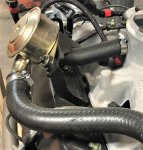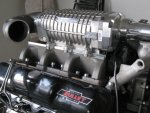- 1,948
- 1,255
- 113
- Location
- Paris KY
I am considering supercharging my new P400 engine and was wondering what would happen when I completely remove my CDR valce and piping. In thinking about this, I began pondering what happens to the valve when adding a turbo or supercharger, as the additional boost/intake pressure would obviously traverse into the valve and either increase crankcase pressure or add stress to the valve diaphram.
Because our OEM 6.2 engines are naturally aspirated, which means there is a vacuum inside the intake when the pistons draw air into the engine for combustion, does this mean this NA engine vacuum is supposed to suck air past the valve to prevent pressure build-up inside the crankcase from blow-by? Or, does the valve control pressure inside the crankcase and allow excess pressure to escape into the combustion air as needed? If the CDR valve was completely eliminated, couldn't a vented oil fill cap serve the same purpose?
It seems to me that changing the static air inside the intake from suction to pressure may actually defeat the purpose of the CDR valve completely. Regardless, my CDR valve will have to be eliminated when the supercharger goes on. Just wondering what to do about venting the crankcase afterwards.
Thanks in advance for comments.


Because our OEM 6.2 engines are naturally aspirated, which means there is a vacuum inside the intake when the pistons draw air into the engine for combustion, does this mean this NA engine vacuum is supposed to suck air past the valve to prevent pressure build-up inside the crankcase from blow-by? Or, does the valve control pressure inside the crankcase and allow excess pressure to escape into the combustion air as needed? If the CDR valve was completely eliminated, couldn't a vented oil fill cap serve the same purpose?
It seems to me that changing the static air inside the intake from suction to pressure may actually defeat the purpose of the CDR valve completely. Regardless, my CDR valve will have to be eliminated when the supercharger goes on. Just wondering what to do about venting the crankcase afterwards.
Thanks in advance for comments.




